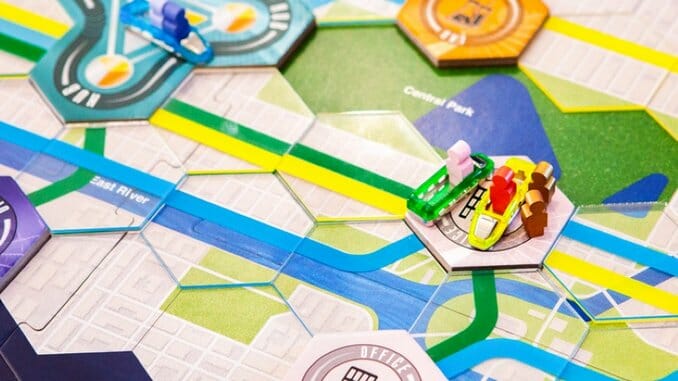The Great Maglev Metro Isn’t Just Another Train Game

Does the world really need another train game? I feel like the answer is always “yes,” even though trains are rather well-represented, to put it mildly, in the tabletop gaming space. BoardGameGeek lists 1351 train games on its site, or about 1% of all games in its comprehensive database. Perhaps the best family game of all time, Ticket to Ride, is a train game at its heart. Steam (also published as Age of Steam) is the king of pickup-and-delivery games. Brass, by the same designer as Steam, is a favorite among fans of heavy economic games. Colt Express, which won the Spiel des Jahres a few years ago, pits the players as bandits all robbing the same train in the Old West.
Maglev Metro enters this crowded space with a very familiar pickup-and-delivery mechanic, but changes the dynamic of most train games by getting rid of blocking moves, taking advantage of better manufacturing to include high-quality clear plastic components that stack on the game board. This reroutes the competition (pun intended) away from worrying about where your opponents are building and focuses it on delivering the most valuable passengers to the right stations, with certain passengers more useful early in the game and others more useful at endgame.
The game comes with a two-sided board, showing Berlin on one side and Manhattan on the other, with a few differences between the two; the rulebook suggests Manhattan is better for casual players, but I think they’re just different rather than one being easier. Players will then work to place their tracks, shown on clear plastic hex tiles, between the stations there at the start of the game and the recessed hex spaces on the board, in which they’ll build the 11 stations to which you’ll deliver the game’s various meeples.
There are seven types of meeples, three robots in metallic colors (gold, silver, and copper) and four passengers in pastels (light and dark purple, pink, and coral). When you deliver a meeple to the matching station, you can place it on your player board, which has recessed spots that show what color of meeple can go in them. Robot meeples are functional, but don’t deliver points; you primarily use them to unlock more actions or expand the power of existing actions (e.g., laying two tracks per action instead of one). Passengers are primarily there for points, as you get points for the passengers you have at game-end, and placing them in the right rows or columns can score you more points per passenger or let you score more of your personal objective cards. You get two actions per turn to start the game, but can boost that by placing four specific meeples in the three rows for that purpose, and you can’t place any of the pastel stations until you’ve unlocked those with two meeples apiece, again in specific combinations.
You have a slew of choices for your actions each turn, and the ones you use will vary as the game progresses. The most important one is laying tracks, one per ‘unit’ on your board in that row, up to four for one action. You may lay those tracks anywhere, as long as you don’t exceed two tracks connecting to any station (your line can’t branch out of any station, except from the central Hub on the Manhattan board). When you’ve laid tracks to an empty, recessed hex, you can build a station there for an action. You can move your train for an action. Picking up passengers and dropping them off are each separate actions, and at the start you can only handle one passenger per action—and you can only carry one passenger until you use robot meeples to boost your capacity. You can even use the adjust action to move robot meeples (never passengers) on your board if you need to boost different actions.
-

-

-

-

-

-

-

-

-

-

-

-

-

-

-

-

-

-

-

-

-

-

-

-

-

-

-

-

-

-

-

-

-

-

-

-

-

-

-

-









































